Input interpretation

pentachloroethane
Chemical names and formulas

formula | CCl_3CHCl_2 Hill formula | C_2HCl_5 name | pentachloroethane IUPAC name | 1, 1, 1, 2, 2-pentachloroethane alternate names | 1, 1, 1, 2, 2-pentachloroethane | ethane pentachloride | ethane, pentachloro- | ethane pentafluoride | pentalin mass fractions | C (carbon) 11.9% | Cl (chlorine) 87.6% | H (hydrogen) 0.498%
Lewis structure
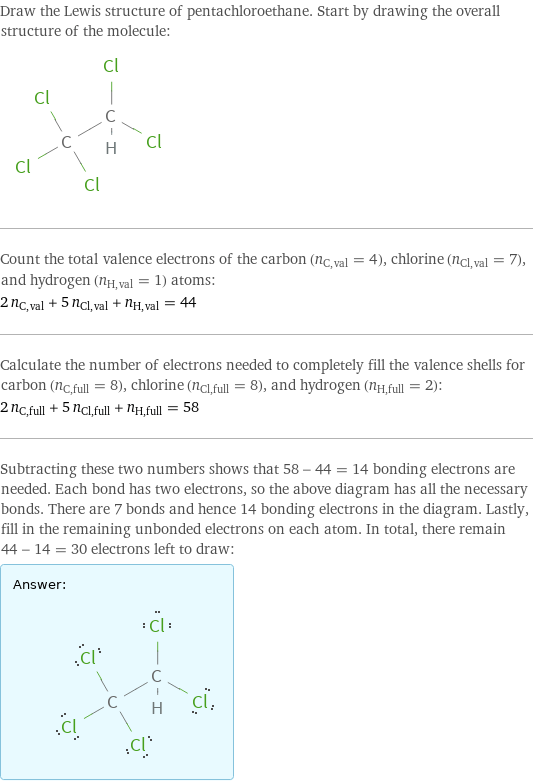
Draw the Lewis structure of pentachloroethane. Start by drawing the overall structure of the molecule: Count the total valence electrons of the carbon (n_C, val = 4), chlorine (n_Cl, val = 7), and hydrogen (n_H, val = 1) atoms: 2 n_C, val + 5 n_Cl, val + n_H, val = 44 Calculate the number of electrons needed to completely fill the valence shells for carbon (n_C, full = 8), chlorine (n_Cl, full = 8), and hydrogen (n_H, full = 2): 2 n_C, full + 5 n_Cl, full + n_H, full = 58 Subtracting these two numbers shows that 58 - 44 = 14 bonding electrons are needed. Each bond has two electrons, so the above diagram has all the necessary bonds. There are 7 bonds and hence 14 bonding electrons in the diagram. Lastly, fill in the remaining unbonded electrons on each atom. In total, there remain 44 - 14 = 30 electrons left to draw: Answer: | |
3D structure

3D structure
Basic properties
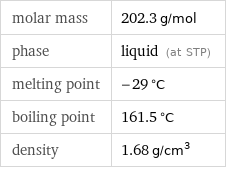
molar mass | 202.3 g/mol phase | liquid (at STP) melting point | -29 °C boiling point | 161.5 °C density | 1.68 g/cm^3
Units

Liquid properties (at STP)
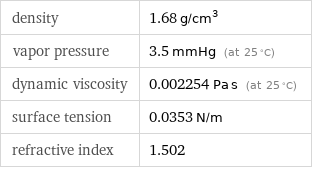
density | 1.68 g/cm^3 vapor pressure | 3.5 mmHg (at 25 °C) dynamic viscosity | 0.002254 Pa s (at 25 °C) surface tension | 0.0353 N/m refractive index | 1.502
Units

Thermodynamic properties
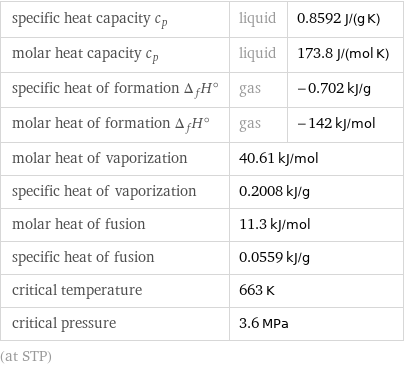
specific heat capacity c_p | liquid | 0.8592 J/(g K) molar heat capacity c_p | liquid | 173.8 J/(mol K) specific heat of formation Δ_fH° | gas | -0.702 kJ/g molar heat of formation Δ_fH° | gas | -142 kJ/mol molar heat of vaporization | 40.61 kJ/mol | specific heat of vaporization | 0.2008 kJ/g | molar heat of fusion | 11.3 kJ/mol | specific heat of fusion | 0.0559 kJ/g | critical temperature | 663 K | critical pressure | 3.6 MPa | (at STP)
Chemical identifiers
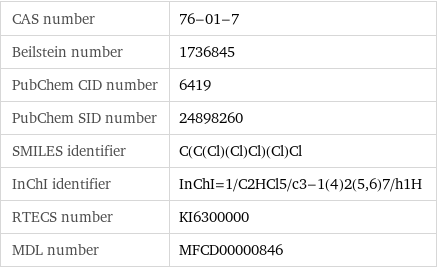
CAS number | 76-01-7 Beilstein number | 1736845 PubChem CID number | 6419 PubChem SID number | 24898260 SMILES identifier | C(C(Cl)(Cl)Cl)(Cl)Cl InChI identifier | InChI=1/C2HCl5/c3-1(4)2(5, 6)7/h1H RTECS number | KI6300000 MDL number | MFCD00000846
Safety properties

flash point | 52 °C

DOT hazard class | 6.1 DOT numbers | 1669
Toxicity properties

RTECS classes | tumorigen | drug | mutagen